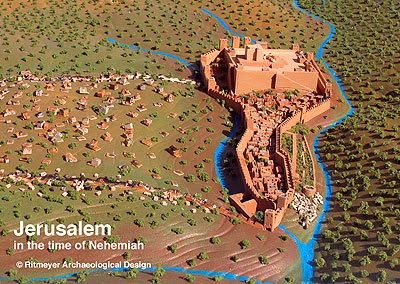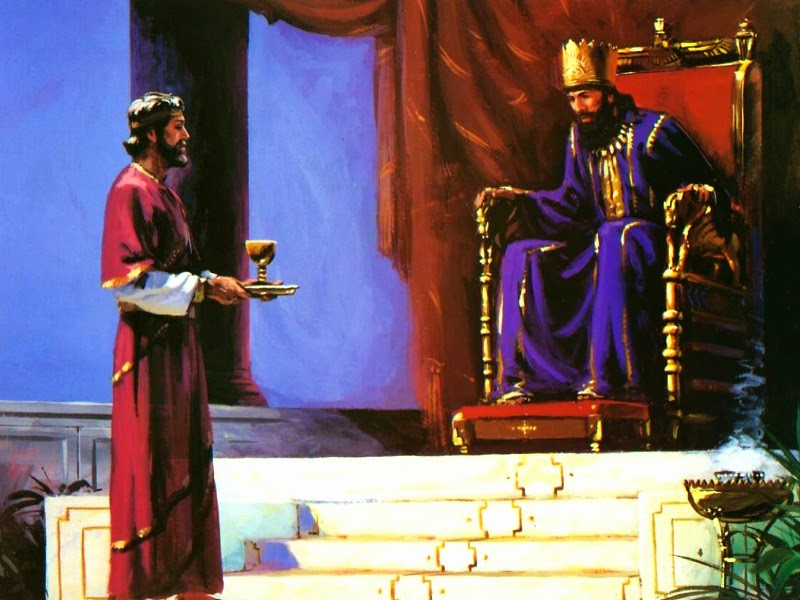The Book of Nehemiah, Background
Title
Nehemiah, whose name means “Jehovah comforts,” is a
famous cupbearer, and does not appear in Scripture outside of this book. As with the books of Ezra and Esther,
named after his contemporaries, the book accounts selected events of his
leadership and was titled after him. Both the Greek Septuagint (LXX) and the
Latin Vulgate named this book “Second Ezra.” Even though the two books of Ezra
and Nehemiah are separate in most English Bibles, they may have once ben joined
together in a single unit as currently in the Hebrew texts. New Testament
writers do not quote Nehemiah.
Author and Date
Though much of this book was clearly drawn from
Nehemiah’s personal diaries and written from his first person perspective
(1:1-7:5; 12:27-43; 13:4-31), both Jewish and Christian traditions recognize
Ezra as the author. This is based on external evidence that Ezra and Nehemiah
were originally one book as reflected in the LXX and Vulgate; it is also based
on internal evidence such as the recurrent “hand of the Lord” theme which
dominates both Ezra and Nehemiah and the author’s role as a priest-scribe. As a
scribe, he had access to the royal archives of Persia, which accounts for the
myriad of administrative documents found recorded in the two books, especially
in the book of Ezra. Very few people would have been allowed access to the
royal archives of the Persian Empire, but Ezra proved to be the exception (cf.
Ezr 1:2-4; 4:9-22; 5:7-17; 6:3-12).
The events in Nehemiah 1 commence late in the year 446
B.C., the 20th year of the Persian king, Artaxerxes (464-423 B.C.).
The book follows chronologically from Nehemiah’s first term as governor of
Jerusalem ca. 445-433 B.C. (Ne 1-12) to his second term, possibly beginning ca.
424 B.C. (Ne 13). Nehemiah was written by Ezra sometime during after Nehemiah’s
second term, but no later than 400 B.C.
 True to God’s promise of judgment, He brought the
Assyrians and Babylonians to deliver His chastisement upon wayward Judah and
Israel. In 722 B.C. the Assyrians deported the 10 northern tribes and scattered
them all over the then known world (2Ki 17). Several centuries later, ca.
605-586 B.C., God used the Babylonians to sack, destroy, and nearly depopulate
Jerusalem (2Ki 25) because Judah had persisted in her unfaithfulness to the
covenant. God chastened His people with 70 years of captivity in Babylon (Jer
25:11).
True to God’s promise of judgment, He brought the
Assyrians and Babylonians to deliver His chastisement upon wayward Judah and
Israel. In 722 B.C. the Assyrians deported the 10 northern tribes and scattered
them all over the then known world (2Ki 17). Several centuries later, ca.
605-586 B.C., God used the Babylonians to sack, destroy, and nearly depopulate
Jerusalem (2Ki 25) because Judah had persisted in her unfaithfulness to the
covenant. God chastened His people with 70 years of captivity in Babylon (Jer
25:11).
During the Jews’ captivity, world empire leadership
changed hands from Babylonians to the Persians (ca. 539 B.C.), after which
Daniel received most of his prophetic revelation (cf. Da 6, 9-12). The book of
Ezra begins with the decree of Cyrus, a Persian king, to return to God’s people
to Jerusalem to rebuild God’s house (ca. 539 B.C.), and chronicles the
reestablishment of Judah’s national calendar of feasts and sacrifices.
Zerubbabel and Joshua led the first return (Ezr 1-6) and rebuilt the temple.
Esther gives a glimpse of the Jews left in Persia (ca. 483-473 B.C.) when Haman
attempted to eliminate the Jewish race. Ezra 7-10 recounts the second return
led by Ezra in 485 B.C. Nehemiah chronicles the third return to rebuild the
wall around Jerusalem (ca. 445 B.C.).
At that time in Judah’s history, the Persian Empire
dominated the entire North Eastern world. Its administration of Judah, although
done with a loose hand, was mindful of disruptions or any signs of rebellion
from its vassals. Rebuilding the walls of conquered cities posed the most
glaring threat to the Persian central administration. Only a close confidant of
the king himself could be trusted with such an operation. At the most critical
juncture in Judah’s revitalization, God raised up Nehemiah to exercise on of
the most trusted roles in the empire, the King’s cupbearer and confidant. Life
under the Persian king Artaxerxes (ca. 464-423 B.C.) had its advantages for
Nehemiah. Much like Joseph, Esther, and Daniel, he had attained a significant
role in the palace which then ruled the ancient world, a position from which
God could use him to lead the rebuilding of Jerusalem’s walls in spite of its
implications for Persian control of that city.
Several other historical notes are of interest. First,
Esther was Artaxerxes’ stepmother and could have easily influenced him to look
favorably upon the Jews, especially Nehemiah. Second, Daniel’s prophetic 70
weeks began with the decree to rebuild the city issued by Artaxerxes in 445
B.C. (cf. ch 1,2). Third, the Elephantine papyri (Egyptian documents), dated to
the late 5th century B.C., support the account of Nehemiah by
mentioning Sanballat the governor of Samaria (2:19), Jehohanan (6:18, 12:23),
and Nehemiah’s being replaced as governor of Jerusalem by Bigvai (ca. 410 B.C.;
Ne 10:16). Finally, Nehemiah and Malachi represent the last of the OT canonical
writings, both in terms of the time the events occurred (cap. 13; Mal 1-4) and
the time when they were recorded by Ezra. Thus the next messages from God for
Israel do not come until over 400 years of silence had passed, after which the
births of John the Baptist and Jesus Christ were announced (Mt 1; Lk 1,2).
With the full OT revelation of Israel’s history prior to
Christ’s incarnation being completed, the Jews had not yet experience d the
fullness of God’s various covenants and promises to them. While there was a
Jewish remnant, as promised to Abraham (cf. Ge 15:5), it does not appear to be
even as large as at the time of the Exodus (Nu 1:46). The Jews neither
possessed the Land (Ge 15:7) nor did they rule as a sovereign nation (Ge 12:2).
The Davidic throne was unoccupied (cf. 2Sa 7:16), although the High-Priest was
of the line of Eleazar and Phinehas (cf. Nu 25:10-13). God’s promise to
consummate the New Covenant of redemption awaited the birth, crucifixion, and resurrection
of Messiah (cf. Heb 7-10).
Historical and Theological Themes
 Careful
attention to the reading of God’s Word in order to perform His will is a
constant theme. The spiritual revival came in response to Ezra’s reading of
“the book of the law of Moses” (8:1). After the reading, Ezra and some of the
priests carefully explained its meaning to the people in attendance (8:8). The
next day, Ezra met with some of the fathers of the households, the priests, and
Levites, in order to “gain insight into the words of the law” (10:34,36). So
deep was their concern to abide by God’s revealed will that they took “a curse
and an oath to walk in God’s law...” (10:29, NASB). When the marriage reforms
were cried out, they acted in accordance with that which “they read aloud from
the book of Moses” (13:1).
Careful
attention to the reading of God’s Word in order to perform His will is a
constant theme. The spiritual revival came in response to Ezra’s reading of
“the book of the law of Moses” (8:1). After the reading, Ezra and some of the
priests carefully explained its meaning to the people in attendance (8:8). The
next day, Ezra met with some of the fathers of the households, the priests, and
Levites, in order to “gain insight into the words of the law” (10:34,36). So
deep was their concern to abide by God’s revealed will that they took “a curse
and an oath to walk in God’s law...” (10:29, NASB). When the marriage reforms
were cried out, they acted in accordance with that which “they read aloud from
the book of Moses” (13:1).
A
second major theme, the obedience of Nehemiah, is explicitly referred to
throughout the book due to the fact that the book is based on the memoirs or
first person accounts of Nehemiah. God worked through the obedience of
Nehemiah; hover, He also worked through wrongly-motivated, wicked hearts of His
enemies. Nehemiah’s enemies failed, not so much as a result of the success of
Nehemiah’s strategies, but because “God had frustrated their plan” (4:15). God
used the opposition of Judah’s enemies to drive His people to their knees in
the same way that He used the favor of Cyrus to return His people to the Land,
to fund their building project, and to even protect the reconstruction of
Jerusalem’s walls. Not surprisingly, Nehemiah acknowledged the true motive of
his strategy to repopulate Jerusalem: “my God put into my heart” (7:5). It was
He who accomplished it.
Another
theme in Nehemiah, as in Ezra, is opposition. Judah’s enemies started rumors
that God’s people had revolted against Persia. The goal was to intimidate Judah
into forestalling reconstruction of the walls. In spite of opposition from
without heartbreaking corruption and dissension from within, Judah completed
the walls of Jerusalem in only 52 days (6:15), experienced revival after the
reading of the law by Ezra (8:1 fwd.), and celebrated the Feast of Tabernacles
(8:14 fwd.; ca. 445 B.C.).
The book’s detailed insight into
personal thoughts, motives, and Nehemiah’s disappointments makes it easy for
the reader to primarily identify with him, rather than “the sovereign hand of
God” theme and the primary message of His control and intervention into the
affairs of His people and their enemies. But the exemplary behavior of the famous
cupbearer is eclipsed by God, who orchestrated the reconstruction of the walls
in spite of much opposition and many setbacks; the “good hand of God” theme
carries through the book of Nehemiah (1:10; 2:8, 18).
Interpretive Challenges
First, since much of Nehemiah is explained in relationship
to Jerusalem’s gates (cf. Ne 2, 3, 8, 12), one needs to see the map “Jerusalem
in Nehemiah’s Day” for an orientation. Second, as you read it is important to
recognize that the time line of chapter 1-12 encompassed about one year (445
B.C.), followed by a long gap of time (over 20 years) after Ne 12 and before Ne
13 (ref Time Line of Nehemiah).
Finally, quickly recognize that Nehemiah actually served two governorships in
Jerusalem, the first from 445-433 B.C. (cf. Ne 5:14; 13:6) and the second
beginning possibly in 424 B.C. and extending to no longer than 410 B.C.
Time Line of Nehemiah
Reference Date Event
1:1,4 Nov/Dec 446 B.C. (Kislev) Nehemiah hears of problems and prays.
2:1-6 Mar/Apr 445 B.C. (Nisan) Nehemiah is dispatched to Jerusalem.
3:1; 6:15 Jul/Aug 445 B.C. (Ab) Nehemiah starts the wall.
6:15 Aug/Sep 445 B.C. (Elul) Nehemiah completes the wall.
7:73b Sep/Oct 445 B.C.
(Tishri) Day of Trumpets
celebrated (implied).
8:13-15 Sep/Oct 445 B.C. (Tishri) Feast of Booths celebrated.
9:1 Sep/Oct 445 B.C. (Tishri) Time of confession.
12:27 Sep/Oct 445 B.C.
(Tishri) Wall dedicated.
13:6 445-433 B.C. Nehemiah’s first term as governor (1-12)
13:6 433-424 B.C. (?) Nehemiah returns to Persia.
No ref. 433-? B.C. Malachi
prophesies in Jerusalem during
Nehemiah’s absence.
13:1,4,7 427-? B.C. Nehemiah
returns and serves a second
term as governor (Ne 13).
Outline
I. Nehemiah’s First Term as Governor (1:1-12:47)
A. Nehemiah’s
Return and Reconstruction (1:1-7:73a)
1.
Nehemiah goes to Jerusalem (1:1-2:20)
2. Nehemiah
and the people rebuild the walls (3:1-7:3)
3.
Nehemiah recalls the first return under Zerubbabel (7:4-73a)
B. Ezra’s Revival
and Renewal (7:73b-10:39)
1.
Ezra expounds the law (7:73b-8:12)
2. The
people worship and repent (8:13-9:37)
3.
Ezra and the priests renew the covenant (9:38-10:39)
C. Nehemeiah’s
Resettlement and Rejoicing (11:1-12:47)
1.
Jerusalem is resettled (11:1-12:26)
2. The
people dedicate the walls (12:27-47)
II. Nehemiah’s second term as Governor (13:1-31)
MacArthur Study Bible, NASB, Updated Edition.
2006. Nelson Bibles, Thomas Nelson. La Habra, CA.





